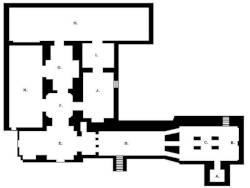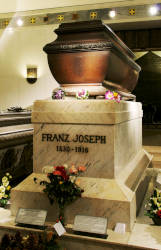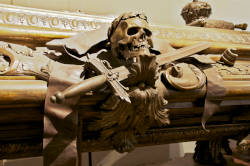Kapuzinergruft
Useful Information


| Location: |
Tegetthoffstraße 2, 1010 Wien.
(48.205671, 16.370164) |
| Open: |
All year daily 10-18. 24-DEC 10-16. 31-DEC 10-15. 01-JAN 12-18. Last entry 30 minutes before closure. [2023] |
| Fee: |
Adults EUR 8, Children (6-18) EUR 4.80, Children (0-5) free, Students (-27) EUR 7, Seniors EUR 7, Disabled EUR 7, Family (2+*) EUR 17.50. Groups (10+): Adults EUR 7. [2023] |
| Classification: |
 Crypt Crypt
|
| Light: |
 Incandescent Incandescent
|
| Dimension: | T=19 °C. |
| Guided tours: | self guided |
| Photography: | |
| Accessibility: | no |
| Bibliography: | |
| Address: |
Kapuzinergruft, Tegetthoffstraße 2, 1010 Wien, Tel: +43-1-512-685388.
E-mail: |
| As far as we know this information was accurate when it was published (see years in brackets), but may have changed since then. Please check rates and details directly with the companies in question if you need more recent info. |
|
History
| 1618 | first burial in the crypt. |
Description




The Kapuzinergruft (Capuchin crypt), also known as Kaisergruft (Imperial Crypt), is located under the Kapuzinerkirche (Capuchin Church). It is under the custody of the Capuchin Order, hence the name. It is intended for members of the former Austrian ruling house of Habsburg. The members of the house of Habsburg have been buried in the crypt since 1633 and are still buried here. The last were Zita, the last Austrian empress, buried in 1989 and her eldest son, the former Crown Prince and European politician Otto Habsburg together with his wife Regina in 2011. 149 Habsburgs, including 12 emperors and 22 empresses and queens, have found their final resting place here. The last emperor to be buried here was Franz Joseph I in 1916.
Some sarcophaguses are works of art, and very representative. Maria Theresa and her husband, Emperor Francis I Stephen of Lorraine, have a magnificent double sarcophagus which is a work by Balthasar Ferdinand Moll. There are lots of skulls, Putti and mourning angels, made of stone iron, bronze and whatever. There are a total of ten vaults, a result of multiple extensions and modifications over four centuries.
The crypt was created by Kaiserin Anna von Tirol, daughter of Archduke Ferdinand II von Tirol and Anna Katharina of Mantua. The crowned wife of Emperor Matthias donated the Capuchin monastery and the imperial crypt in her will. She was the first to be buried here in 1618, her husband one year later.
And the ritual distribution of mortal remains in different places is a weird but actually quite common habit. The custom was motivated by hygienic reasons since earliest antiquity. In the case of the Habsburgs, the mortal remains are in the Capuchin crypt, the entrails in the entrails crypt under the choir of St Stephen’s Cathedral and the hearts in the heart crypt in the Augustinian Church. However, it was done only between 1654 and 1878.
 Search DuckDuckGo for "Kapuzinergruft"
Search DuckDuckGo for "Kapuzinergruft" Google Earth Placemark
Google Earth Placemark OpenStreetMap
OpenStreetMap Imperial Crypt - Wikipedia (visited: 04-JUN-2025)
Imperial Crypt - Wikipedia (visited: 04-JUN-2025) Kapuzinergruft, official website
Kapuzinergruft, official website  (visited: 11-JAN-2023)
(visited: 11-JAN-2023) Index
Index Topics
Topics Hierarchical
Hierarchical Countries
Countries Maps
Maps